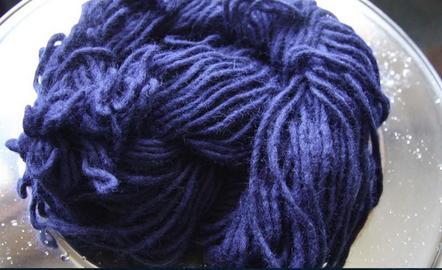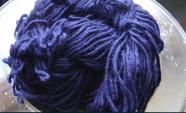Developing eco-friendly fabrics
Introduction
Dr Sandy Heffernan is a senior lecturer in the Institute of Industry and Environment, part of Massey University’s College of Creative Arts in Wellington.
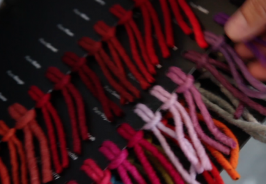
A number of her Masters students in the textile design programme have been working on innovative ideas for:
- using wool waste
- eco-friendly dyeing of wool
- digital embroidery.
Sandy has been working in partnership with Wellington company The Formary to develop a new yarn that is a blend of rice-straw and wool.
New developments
From wool waste to fine textiles
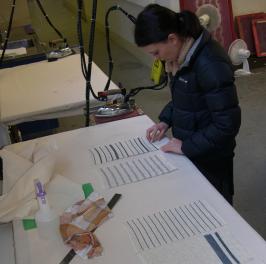
Wool waste usually ends up as insulation products that add little value to the resource. Masters student Stacey Ellis set herself the task of exploring other applications that might return a greater profit. Yarn spinning companies were supportive. Not only are they keen to get more value from their waste; they also want to demonstrate responsible, sustainable practice.
Stacey collected yarn waste from Summit Wool Spinners (Oamaru), Radford Yarn Technologies Limited (Christchurch), and Woolyarns Limited (Lower Hutt).
Using a combination of craft skills and modern technologies, she created a felt material with digital embroidery for high-end upholstery, and woven, knitted, and printed materials. She even used macramé to upholster a chair.
Sustainable yarn dyeing
Rebekah Harman, also a Masters student, worked with Carpets and Rugs of New Zealand (CRONZ) to develop more environmentally friendly dyeing processes.
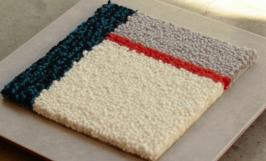
The textile industry has become increasingly interested in sustainability, but sustainable dyeing practices are hard to achieve given the energy required and the complex interplay between dye and yarn.
In her research into more sustainable dyeing methods, Rebekah tested multiple options, ran experiments, and carried out market research. The result was a short list of promising options that the company is now following up with its dyers.
The New Zealand Herald featured an article about CRONZ and Rebekah’s work: “Small business: John Wyma – CRONZ”
Rice-straw-and-wool textiles
Wellington company The Formary found a way of successfully blending waste fabric from coffee sacks with wool to produce an upholstery fabric known as WoJo®; now it is looking at blending rice-straw and wool.
On a visit to China, one of The Formary’s principals saw that huge amounts of straw waste were a byproduct of rice growing. In a follow-up visit funded by Wellington City Council, they were able to investigate the potential for using this waste.
Since then, Dr Sandy Heffernan and Massey University colleagues have worked with The Formary to develop an upholstery fabric made by blending the rice-straw with wool. The Beef and Lamb Authority are providing research funding. The underpinning theme of this research is sustainability.
Rice-straw is usually burnt when the harvest is complete, greatly adding to air pollution. As the population of the world grows, so will the volume of rice-straw waste and consequent pollution. Recognising the seriousness of the issue, China aims to find better uses for 75% of its rice waste within five years.
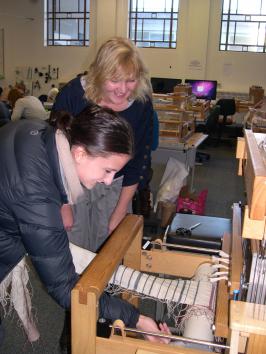
Dr Heffernan carried out exploratory work to see if it was technically feasible to blend straw and wool. When Dr Heffernan and The Formary were satisfied that it was, Woolyarns New Zealand (Lower Hutt) were approached to spin the prototype yarn.
Masters student Stacey Ellis then designed and wove swatches using the rice-straw-and-wool yarn. The Formary presented these to the Chinese minister of agriculture during a Wellington mayoral delegation visit.
The long-term plan is for the blend and the fabric to be manufactured in Yixing, which aims to be a scientific and sustainable development demonstration city.
Massey University’s research into rice-straw is ongoing.
The following resources give more information about rice-straw-and-wool textiles.
- “Boundaries ‘limitless’ for new eco-fabric”
- “The Formary”
- “The Formary – World Changing Transformation”
- “Weaving ideas from waste systems”
Have you seen ...?
Technological modelling in tie-dyeing
Dorothy Hutton of Columba College used tie-dyeing to teach the functional modelling aspect of technological modelling to her year 6 students.
A WOW costume inspired by a longhorn beetle
Maia Holder-Monk created an exciting and original WOW costume for the Te Papa windows in a WOW festival.
